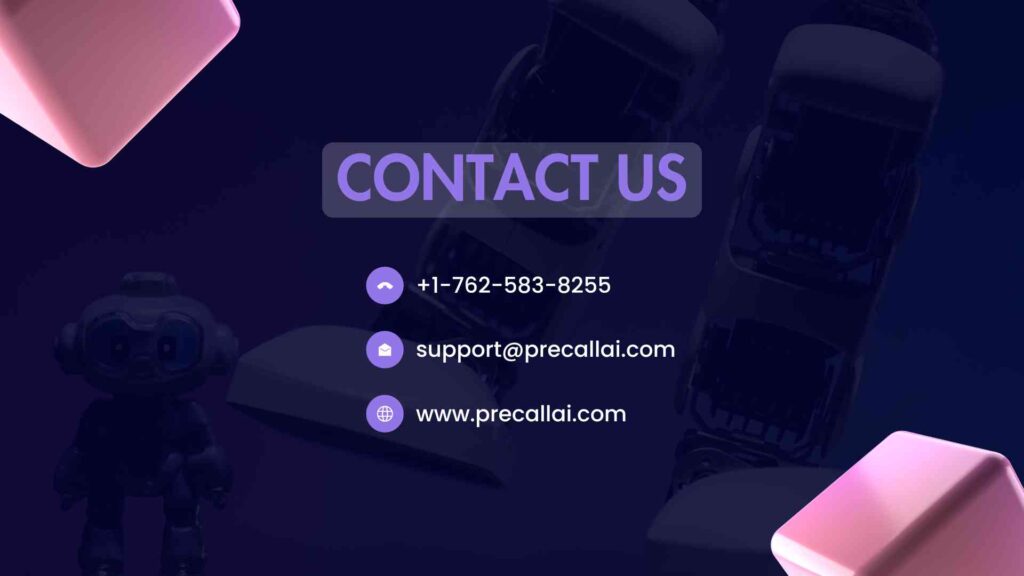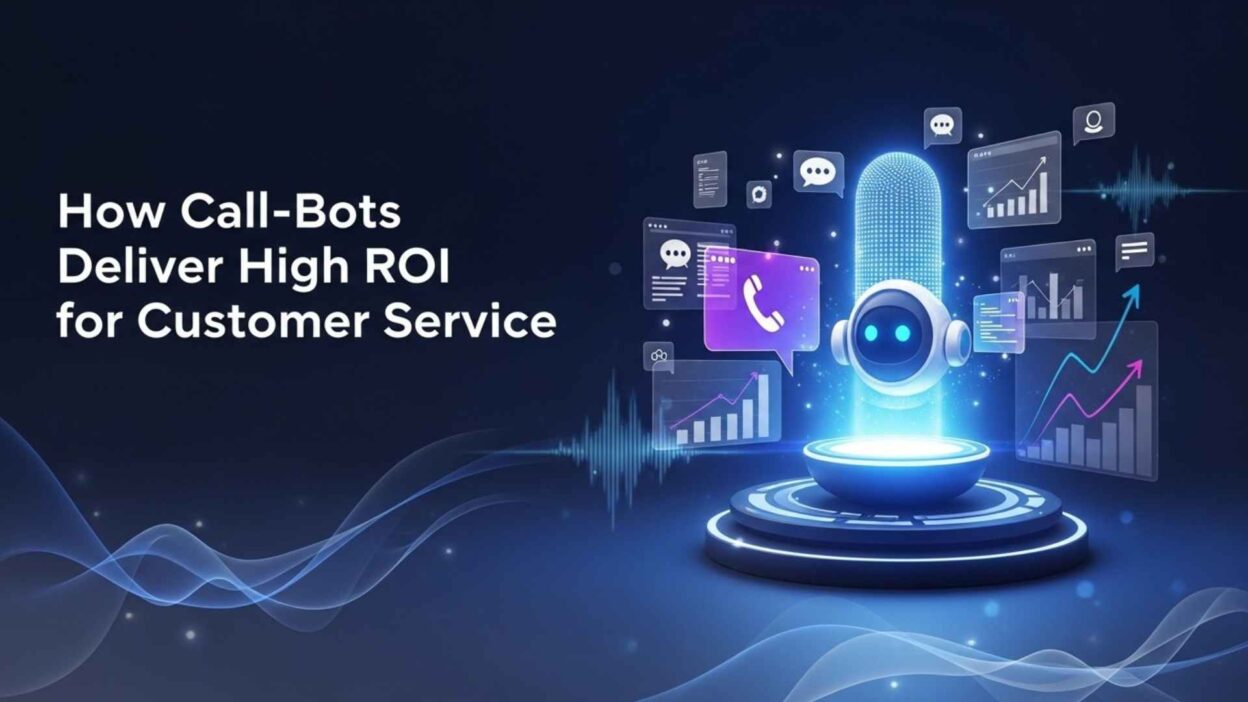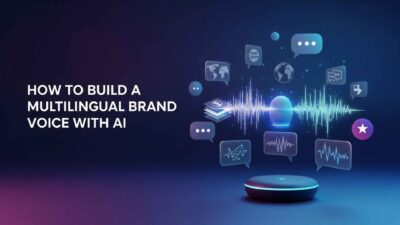Introduction
Table of Contents
TL;DR Customer service departments face mounting pressure to deliver excellence while controlling costs. Call-bots have emerged as the solution that satisfies both demands simultaneously. These intelligent automated systems handle thousands of conversations without human fatigue or errors. The Call-Bot ROI for Customer Service Centres proves substantial across every measurable metric. Companies report cost savings of 30-60% within the first year of deployment. Customer satisfaction scores often improve rather than decline with bot implementation. This comprehensive guide examines how call-bots generate impressive returns on investment.
Understanding Call-Bot Technology in Customer Service
Call-bots represent advanced artificial intelligence designed specifically for customer conversations. These systems understand natural language and respond with contextually appropriate answers. Modern call-bots handle complex queries that previously required human agents exclusively. The technology has evolved far beyond simple menu navigation systems. Natural language processing enables conversations that feel surprisingly human. Call-Bot ROI for Customer Service Centres starts with understanding the technological foundation.
Core Components of Call-Bot Systems
Speech recognition software converts customer voice into analyzable text instantly. Natural language processing engines determine the intent behind each customer statement. Knowledge bases provide accurate information for thousands of common queries. Machine learning algorithms improve response quality with every interaction. Integration layers connect call-bots to CRM systems and databases seamlessly. Voice synthesis technology delivers responses that sound natural and professional.
Evolution from Basic IVR Systems
Interactive Voice Response systems offered limited menu-based navigation historically. Customers pressed buttons to navigate rigid predetermined paths frustratingly. Modern call-bots understand conversational requests without button pressing requirements. The technology recognizes context from previous statements during the conversation. Emotional intelligence features detect customer frustration and adjust responses accordingly. This evolution represents a quantum leap in automated customer service capability.
Primary ROI Driver: Dramatic Cost Reduction
Labor represents the largest expense category for most customer service operations. Call-bots handle routine inquiries at a fraction of human agent costs. The Call-Bot ROI for Customer Service Centres becomes immediately visible in payroll savings. A single call-bot manages thousands of simultaneous conversations efficiently. Human agents handle only complex situations that truly require personal attention. Organizations redirect labor budgets toward strategic initiatives instead of routine inquiries.
Quantifying Direct Labor Savings
Customer service representatives cost $30,000-$50,000 annually including benefits and overhead. Call-bots handle 60-80% of incoming inquiries without human intervention needed. A team of 50 agents potentially reduces to 10-15 specialized problem-solvers. Annual savings often reach $1-2 million for mid-sized contact centers. Enterprise operations save $10-20 million yearly through strategic call-bot deployment. These figures exclude additional savings from reduced training and turnover costs.
Infrastructure and Overhead Reductions
Physical office space requirements shrink when automation handles most interactions. Utility costs decline with smaller facilities and fewer workstations needed. IT infrastructure scales efficiently with cloud-based call-bot platforms. Supervisory staff requirements decrease when fewer agents need management oversight. Equipment purchases drop significantly with reduced headcount requirements. Total cost of ownership calculations reveal compounding savings beyond direct labor.
Enhanced Customer Experience Metrics
Customer satisfaction improves when wait times disappear completely from the equation. Call-bots provide instant responses 24 hours daily without breaks or holidays. Consistency in service quality eliminates the variability inherent with human agents. The Call-Bot ROI for Customer Service Centres includes measurable experience improvements. First-call resolution rates often increase by 15-25% with bot implementation. Net Promoter Scores rise as customers appreciate immediate problem resolution.
Zero Wait Time Achievement
Traditional contact centers force customers to wait in queues during peak hours. Call-bots eliminate hold music and “your call is important to us” messages. Every customer receives immediate attention regardless of call volume spikes. Holiday seasons and promotional periods no longer overwhelm service capacity. Customer frustration decreases dramatically when problems get addressed instantly. This responsiveness creates competitive differentiation that drives customer loyalty measurably.
24/7 Availability Without Premium Costs
Human agent coverage for nights and weekends requires expensive shift differentials. Call-bots operate continuously without additional compensation requirements. International customers receive support in their local time zones seamlessly. Emergency situations get handled immediately rather than waiting for business hours. Service level agreements become easier to maintain with round-the-clock automation. Global operations benefit particularly from follow-the-sun support without geographic staffing.
Scalability Without Proportional Cost Increases
Seasonal demand fluctuations create staffing nightmares for traditional contact centers. Hiring and training temporary agents proves costly and time-consuming. Call-bots scale instantly to handle Black Friday or post-launch support surges. The Call-Bot ROI for Customer Service Centres includes operational flexibility advantages. Business growth requires minimal service infrastructure expansion with automation. Market expansion happens faster when customer support scales effortlessly.
Handling Volume Spikes Efficiently
Product recalls generate thousands of simultaneous customer inquiries immediately. Call-bots manage the flood without degraded service quality or long waits. Marketing campaigns no longer require advance staffing coordination and overtime budgets. Viral social media moments get handled smoothly without service disruptions. Peak capacity planning becomes simpler when technology absorbs demand spikes. Customer experience remains consistent regardless of volume fluctuations throughout the year.
Geographic Expansion Support
New market entry traditionally requires establishing local customer service operations. Call-bots provide native-language support in dozens of languages instantly. Cultural nuances get programmed into regional bot personalities appropriately. Time zone coverage happens automatically without staffing satellite offices. International expansion timelines accelerate when service infrastructure deploys immediately. Market testing becomes financially viable when support costs stay minimal initially.
Data Collection and Business Intelligence
Every call-bot interaction generates valuable structured data automatically. Customer inquiries reveal product issues, feature requests, and market trends. The Call-Bot ROI for Customer Service Centres extends to strategic business intelligence. Sentiment analysis identifies customer satisfaction trends in real-time dashboards. Product teams receive direct feedback from thousands of customer conversations. Marketing departments gain insights into messaging effectiveness through inquiry patterns.
Real-Time Analytics Capabilities
Traditional quality monitoring reviews small random samples of recorded calls. Call-bots analyze 100% of interactions for patterns and insights. Issue trends become visible within hours rather than weeks later. Executive dashboards display customer sentiment metrics updated continuously. Problem escalation happens automatically when patterns indicate emerging issues. Data-driven decision-making accelerates when information flows instantly from customers.
Predictive Customer Behavior Insights
Machine learning models identify customers likely to churn based on inquiry patterns. Upsell opportunities emerge from analyzing customer needs expressed during conversations. Product defects get detected from inquiry clustering before widespread complaints arrive. Seasonal demand forecasting improves with historical call-bot interaction analysis. Competitive intelligence surfaces when customers mention rival products during conversations. Strategic value from data often exceeds direct cost savings alone.
Improved First-Call Resolution Rates
Call-bots access complete knowledge bases instantly without searching through documents. Consistent answers eliminate the variability from different agent knowledge levels. The Call-Bot ROI for Customer Service Centres includes quality consistency benefits. Customers receive accurate information every time without transfer frustrations. Complex queries get routed to specialized human agents efficiently. Knowledge gaps that plague human teams simply don’t exist with bots.
Knowledge Base Optimization
Call-bots identify gaps in documentation when unable to answer queries. Content teams prioritize knowledge base improvements based on actual customer needs. Answer accuracy improves continuously through machine learning feedback loops. Version control ensures every customer receives current information immediately. Multilingual knowledge bases maintain consistency across different language versions. Information updates deploy instantly to all conversations without retraining requirements.
Reduced Transfer and Escalation Rates
Customers hate getting transferred between multiple agents repeatedly during calls. Call-bots resolve 70-85% of inquiries without human agent involvement needed. Smart routing sends complex issues to the most qualified specialist immediately. Context from the bot conversation transfers seamlessly to human agents. Escalation paths optimize based on issue type and customer value. Customer effort scores improve dramatically with streamlined resolution processes.
Employee Satisfaction and Retention Benefits
Human agents often burn out handling repetitive simple inquiries endlessly. Call-bots eliminate mundane questions so agents tackle interesting challenging problems. The Call-Bot ROI for Customer Service Centres includes workforce engagement improvements. Employee satisfaction increases when work becomes more meaningful and varied. Turnover rates decline when agents feel valued for complex problem-solving skills. Recruitment becomes easier when positions offer genuine intellectual challenges daily.
Focusing Human Talent Strategically
Senior agents handle relationship management with high-value customers exclusively. Complex technical issues go directly to specialists without triage delays. Agent development opportunities expand with focus on advanced skill-building. Career paths become clearer when positions emphasize expertise over call volume. Compensation structures reward problem-solving quality instead of quantity metrics. Workplace culture improves when technology handles the tedious aspects.
Reducing Turnover Costs
Contact center agent turnover averages 30-45% annually across industries. Recruitment costs reach $4,000-$6,000 per position when including training expenses. Call-bot implementation reduces turnover by 15-20% through improved job satisfaction. Savings from retention often match direct labor cost reductions significantly. Institutional knowledge preservation improves with stable experienced teams remaining longer. Customer relationships deepen when the same agents handle complex situations consistently.
Compliance and Quality Assurance Advantages
Regulatory compliance creates documentation burdens and audit trail requirements. Call-bots automatically log every conversation with perfect accuracy permanently. The Call-Bot ROI for Customer Service Centres includes risk mitigation benefits. Script adherence becomes guaranteed when bots follow programmed protocols exactly. Privacy regulations get satisfied through consistent proper data handling. Legal exposure decreases when conversations follow compliant patterns universally.
Audit Trail Documentation
Every customer interaction gets recorded and indexed automatically for retrieval. Dispute resolution becomes straightforward with complete conversation transcripts available. Regulatory audits complete faster with comprehensive documentation readily accessible. Payment Card Industry requirements get satisfied through secure automated processes. Health Insurance Portability and Accountability Act compliance improves with standardized interactions. Documentation costs that plague human operations simply disappear with automation.
Consistent Policy Application
Human agents sometimes bend rules for pushy customers inconsistently. Call-bots apply policies uniformly without emotional manipulation or favoritism. Discount authorization follows programmed rules without manager override requirements. Fraud prevention protocols execute consistently without fatigue or distraction factors. Brand reputation benefits from predictable consistent customer treatment universally. Legal risks diminish when exceptions require explicit human authorization always.
Integration with Existing Technology Stacks
Modern call-bots connect seamlessly with CRM platforms and helpdesk systems. Customer history displays automatically during bot conversations for personalization. The Call-Bot ROI for Customer Service Centres improves through technology ecosystem integration. Order management systems provide real-time status information to bots instantly. Inventory databases enable accurate product availability answers during conversations. Unified customer experiences emerge when systems share data intelligently.
CRM System Connectivity
Salesforce integration enables call-bots to access complete customer relationship histories. Microsoft Dynamics users benefit from automated case creation and updates. HubSpot workflows trigger based on call-bot conversation outcomes automatically. Custom CRM platforms connect through standard API protocols easily. Data synchronization happens in real-time without manual entry requirements. Sales teams receive qualified leads from service conversations automatically.
Omnichannel Experience Consistency
Customers start conversations via chat and continue seamlessly through voice calls. Email inquiries transition to call-bot conversations without repeating information frustratingly. Social media mentions trigger proactive call-bot outreach when appropriate. Mobile app integration provides in-app voice support through call-bots. Channel preferences get respected while maintaining conversation context throughout. Customer journey orchestration improves dramatically with intelligent automation coordination.
Multilingual Support Without Geographic Constraints
Global customer bases require support in dozens of languages simultaneously. Hiring native speakers for every language proves prohibitively expensive traditionally. The Call-Bot ROI for Customer Service Centres includes multilingual capability advantages. Call-bots handle 50+ languages with native pronunciation and cultural awareness. Regional dialect variations get recognized and accommodated automatically. Language barriers disappear when technology provides universal communication capability instantly.
Translation Accuracy and Cultural Nuance
Machine translation has achieved human-level accuracy for most common languages. Cultural context understanding prevents embarrassing miscommunications with international customers. Idiomatic expressions get interpreted correctly rather than literally confusing bots. Regional preferences for formality levels get respected in bot responses. Holiday greetings and cultural references appear appropriately for different markets. Global brand consistency maintains while respecting local cultural expectations simultaneously.
Market Expansion Speed
New country launches happen immediately when language support deploys instantly. Market testing becomes affordable when service infrastructure costs stay minimal. Localization costs shrink dramatically compared to hiring local agent teams. Regulatory compliance gets programmed once and scales across all languages. Competitive advantages emerge from serving markets rivals consider too expensive. International revenue growth accelerates when customer service enables rather than constrains expansion.
Implementation Timeline and Quick ROI Realization
Cloud-based call-bot platforms deploy in weeks rather than months typically. The Call-Bot ROI for Customer Service Centres appears quickly after implementation. Initial pilot programs run 30-60 days before full deployment begins. Return on investment often occurs within 3-6 months of going live. Phased rollouts minimize disruption while proving value incrementally. Quick wins build organizational confidence for broader automation initiatives.
Pilot Program Best Practices
Start with high-volume simple inquiry types that demonstrate clear benefits. Choose use cases where success metrics can be measured easily. Limit initial scope to 10-15% of total call volume for testing. Gather feedback from both customers and agents during the pilot. Measure cost per interaction compared to human-handled calls carefully. Document lessons learned to optimize full-scale deployment approaches.
Full Deployment Strategies
Gradual rollout by inquiry type minimizes risk while building momentum. Geographic phasing works well for organizations with multiple locations. Seasonal timing considers support volume patterns for smoothest transitions. Change management programs prepare both customers and employees appropriately. Communication plans explain the benefits and set realistic expectations. Success celebration events maintain enthusiasm throughout the implementation process.
Measuring and Optimizing Call-Bot Performance
Continuous improvement requires tracking key performance indicators systematically. The Call-Bot ROI for Customer Service Centres demands ongoing optimization efforts. Containment rates measure the percentage of calls handled without human escalation. Customer satisfaction scores assess experience quality with bot interactions. Average handling time comparison shows efficiency gains versus human agents. Cost per interaction calculations demonstrate ongoing financial benefits clearly.
Key Performance Indicators
First-call resolution rates indicate how effectively bots solve customer problems. Sentiment analysis scores reveal customer emotional responses to bot interactions. Transfer rates show how often human intervention becomes necessary. Speech recognition accuracy percentages identify opportunities for improvement. Intent recognition success measures how well bots understand customer requests. Abandonment rates signal when customers give up frustrated with bot interactions.
Continuous Improvement Processes
Machine learning models improve automatically with additional conversation data. A/B testing compares different response approaches for optimization. User feedback triggers immediate knowledge base updates when gaps appear. Monthly performance reviews identify trends and prioritization opportunities. Competitive benchmarking ensures performance stays industry-leading continuously. Innovation roadmaps incorporate emerging AI capabilities as they mature.
Industry-Specific Call-Bot Applications
Retail companies handle order status inquiries and return policy questions automatically. Healthcare providers manage appointment scheduling and prescription refill requests efficiently. Financial services institutions verify account information and process routine transactions securely. Telecommunications firms troubleshoot common technical issues and plan upgrades remotely. Every industry discovers unique high-value call-bot applications that drive ROI.
E-commerce and Retail
Order tracking represents the most common customer inquiry for online retailers. Call-bots access shipping databases and provide real-time delivery updates. Return authorization happens instantly without agent involvement or approval delays. Size and fit questions get answered through product specification lookups. Inventory availability checks happen across multiple warehouses automatically. Promotional code issues get resolved without fraud concerns or escalations.
Financial Services and Banking
Account balance inquiries complete in seconds through secure voice authentication. Transaction disputes initiate automatically with proper documentation and case creation. Credit card activation happens through automated identity verification processes. Loan application status updates provide transparency without agent time investment. Fraud alerts trigger immediate customer contact for verification purposes. Regulatory compliance gets maintained through standardized scripted interactions automatically.
Overcoming Implementation Challenges
Some customers initially prefer human agents for all interactions regardless. Technical integration with legacy systems sometimes creates unexpected complexity. The Call-Bot ROI for Customer Service Centres requires addressing adoption barriers proactively. Voice recognition accuracy varies with accents and background noise factors. Complex emotional situations still require human empathy and judgment. Successful implementations anticipate these challenges and prepare mitigation strategies.
Change Management Strategies
Customer education campaigns explain the benefits and capabilities of call-bots. Progressive rollout allows adjustment periods for both customers and staff. Human escalation options remain clearly communicated and easily accessible always. Agent training emphasizes collaboration between humans and bots productively. Executive sponsorship demonstrates organizational commitment to the technology. Success stories get shared widely to build confidence and acceptance.
Technical Integration Solutions
API development connects call-bots with proprietary legacy systems effectively. Middleware platforms bridge incompatible systems when direct integration proves difficult. Cloud migration of supporting systems simplifies architecture and improves performance. Phased integration approaches minimize disruption to ongoing operations. Experienced implementation partners accelerate timeline and reduce technical risks. Thorough testing prevents customer-facing issues during deployment phases.
Security and Privacy Considerations
Customer data protection represents a critical requirement for service operations. Call-bots must comply with regulations like GDPR and CCPA rigorously. The Call-Bot ROI for Customer Service Centres depends on maintaining customer trust. Voice biometrics provide secure authentication without password frustrations. Encryption protects conversation data during transmission and storage. Access controls limit who can retrieve recorded conversations appropriately.
Compliance Framework Implementation
Privacy policies get updated to disclose automated conversation handling transparently. Consent mechanisms ensure customers understand and agree to bot interactions. Data retention schedules comply with regulatory requirements and best practices. Regular security audits identify and address potential vulnerabilities proactively. Incident response plans prepare for potential breaches or unauthorized access. Training ensures all staff understand privacy obligations and procedures.
Authentication and Fraud Prevention
Multi-factor authentication prevents unauthorized account access during bot conversations. Behavioral analysis detects suspicious patterns that might indicate fraud attempts. Transaction limits trigger human review for high-value or unusual requests. Voice biometric systems recognize authorized users with remarkable accuracy. Fraud detection algorithms improve continuously with machine learning capabilities. Security measures balance protection with customer convenience appropriately.
Future Trends in Call-Bot Technology
Emotional intelligence capabilities will detect customer mood and adapt responses accordingly. Predictive AI will anticipate customer needs before explicit requests get made. The Call-Bot ROI for Customer Service Centres will expand with technological advances. Avatar interfaces will add visual components to voice conversations naturally. Augmented reality integration will enable visual troubleshooting guidance during calls. The possibilities expand exponentially as artificial intelligence continues advancing rapidly.
Generative AI Integration
Large language models enable more natural conversational flows and responses. Creative problem-solving capabilities will handle unprecedented customer situations effectively. Content generation will produce personalized responses rather than templated scripts. Reasoning abilities will tackle multi-step problems requiring logical thinking. Personality customization will match brand voice and customer preferences precisely. These advances will further improve customer experience and operational efficiency.
Proactive Customer Engagement
Call-bots will initiate conversations based on predicted customer needs intelligently. Order delays will trigger proactive outreach before customers call frustrated. Product recommendations will emerge from analyzing customer usage patterns. Renewal reminders will happen at optimal times for conversion. Service opportunities will get identified and pursued automatically. Reactive support will evolve into proactive relationship management systematically.
Frequently Asked Questions About Call-Bot ROI
Payback and Return on Investment
What is the typical payback period for call-bot investments?
Most organizations achieve payback within 6–12 months of full deployment. The ROI for customer service centers appears quickly through reduced labor costs. High-volume operations often reach payback in 3–6 months with aggressive implementation, while smaller contact centers may require 12–18 months depending on scale. Cloud-based solutions minimize upfront costs and accelerate returns, with savings compounding over time as technology continues to improve.
Customer Experience and Reactions
How do customers react to call-bot interactions?
Initial reactions vary, but satisfaction rises as users become familiar with the technology. Younger demographics often prefer automated service, while older customers appreciate clear human escalation options. Instant responses and 24/7 availability generate strong positive feedback. Setting clear expectations about what bots can do helps ensure success. Over time, customer satisfaction scores match or exceed those of human agents.
🤖 Capabilities and Complexity Handling
Can call-bots handle complex customer service issues?
Modern call-bots resolve 70–85% of inquiries without human intervention. However, emotionally sensitive or highly technical cases still benefit from human support. Call-bots excel at routing complex issues to the right specialists quickly. The definition of “complex” continues to shrink as AI improves, and hybrid models combining bots and humans deliver the best overall results today.
👥 Impact on Customer Service Teams
What happens to existing customer service employees?
Strategic implementations redeploy staff to higher-value work instead of replacing them. Routine tasks shift to automation, while employees take on complex problem-solving and specialized roles. Training and upskilling programs help agents advance their careers. Some natural turnover offsets staffing changes, leading to minimal layoffs. Overall, job satisfaction rises as work becomes more meaningful and less repetitive.
💵 Implementation Costs
How much do call-bot systems cost to implement?
Cloud-based call-bot solutions start at $50–$100 per month for small setups. Mid-sized centers typically invest $25,000–$100,000, while enterprise deployments range from $100,000–$500,000 depending on scale. Custom development adds cost but offers unique advantages. Subscription-based pricing reduces upfront expenses, and over time, total ownership costs are much lower than maintaining large human teams.
🔗 Integration with Existing Systems
Do call-bots work with existing phone systems?
Yes — modern call-bots integrate with nearly all business phone systems. Cloud communication platforms offer native compatibility, while traditional PBX systems connect through SIP trunking or APIs. VoIP setups provide especially easy integration. Older systems may need middleware or upgrades, and vendors usually perform compatibility assessments during setup.
🕒 Deployment Timeline
How long does call-bot implementation take?
Simple deployments can finish in 4–8 weeks. More complex integrations take 3–6 months, depending on systems and workflows. Pilot programs typically last 30–60 days to test and refine functionality. The most time-consuming part is building and training the knowledge base, followed by ongoing user training and process adjustments. Many organizations prefer phased rollouts for smoother adoption.
🌍 Language and Global Support
Can call-bots support multiple languages simultaneously?
Yes. Leading call-bot platforms support 50+ languages with natural pronunciation. They can automatically detect and switch languages mid-conversation. AI models now handle cultural nuances and dialects effectively, offering translation quality on par with bilingual human agents. For global companies, multilingual support dramatically enhances customer accessibility and satisfaction.
Read more:-Conversational AI Interruption Handling Like Human Agents
Conclusion

The Call-Bot ROI for Customer Service Centres proves compelling across every dimension. Cost reductions of 30-60% materialize within months of deployment. Customer experience improvements happen simultaneously with financial benefits. Scalability advantages enable business growth without proportional cost increases. Data insights from bot interactions inform strategic business decisions. Employee satisfaction improves when technology handles routine inquiries automatically.
Organizations that delay call-bot adoption risk competitive disadvantage increasingly. Customers expect instant 24/7 support across all communication channels. Traditional staffing models cannot deliver modern service expectations profitably. Early adopters gain market advantages that compound over time. The technology maturity curve has reached the inflection point. Waiting for further improvements means missing current opportunities unnecessarily.
Implementation success requires thoughtful planning and change management focus. Start with pilot programs that demonstrate value quickly and clearly. Choose use cases where benefits appear obvious to build momentum. Measure results rigorously to justify expanded deployment investments. Address concerns transparently about jobs and customer experience impacts. Celebrate successes to maintain organizational enthusiasm throughout the journey.
The future promises even greater capabilities than current impressive systems. Emotional intelligence will make bot conversations indistinguishable from human interactions. Predictive capabilities will enable proactive service that delights customers. Integration with emerging technologies will create seamless omnichannel experiences. Organizations that build call-bot foundations today will leverage tomorrow’s innovations. The question isn’t whether to implement call-bots but how quickly.
Calculate your specific Call-Bot ROI for Customer Service Centres potential today. Identify your highest-volume inquiry types that bots could handle. Estimate labor costs currently dedicated to routine simple questions. Project the customer experience improvements from zero wait times. Consider the strategic value of data insights and scalability. The business case builds itself when you examine the numbers honestly.
Contact call-bot vendors for demonstrations tailored to your industry needs. Request case studies from similar organizations that have implemented successfully. Conduct pilot programs that prove value before committing fully. Engage employees in designing the implementation approach collaboratively. Start your call-bot journey today and position your organization for competitive success.






[…] Read More:-How Call-Bots Deliver High ROI for Customer Service […]